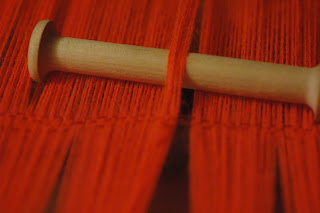What is both fun and horrible about blocking is that it offers an opportunity to fix mistakes. Thus we can all avoid ruined pieces and carefully tweak tiny errors. Of course, the downside is that there's really no excuse for doubled or missed picks.
 |
| No excuse. |
Whether you do this before or after washing is up to you. Generally your fix will need a little blocking to even out. At the same time, some fabrics have so little friction before washing that trying to work with them is maddening. This example had one light washing, but hasn't yet been pressed.
 |
| Find the offending thread, and snip in the center. |
The first trick is finding what exactly went wrong. The simpler the fabric, the easier this is. Consider it a test of your knowledge of structure: Do you have any clue what paths your warp and weft are following?
 |
| Tug from the center to the edge. |
A missed tie-down in huck is relatively easy to parse out, this thread should be following a tabby weave of over one, under one. Since the warp alternates between gray threads and pink/purple threads, this thread should be under grey, over pink/purple. Instead he's following the pattern pick of tabby in Block A, and under one, over one, under five in Block B.
 |
| Find the thread on the selvedge edge. |
Of course, I have no idea why this particular thread decided to be a pattern pick for half of the width, and a tabby pick for half the width. Maybe I was channeling Harvey Dent when treadling that one.
 |
| Pull out offending thread. |
The initial tug from the center does double duty. Errors are most apaprent in the center, so tugging from there is usually much easier then trying to follow with your eyes all the way from the center. Since this scarf has already been washed, it also loosens the thread up from it's neighbors, making it much easier to pull out completely.
 |
| Needle Weaving. |
A pin can be helpful to manipulate threads that want to wiggle away. When you reach the center, try to overlap ends, even if it means adding another piece of thread.
 |
| All fixed! |
Fixing errors is more then simple perfectionism. Poorly made fabrics are more likely to rip, snag, worm, and simply fall apart. A well woven fabric is one that will serve its function for decades.
This scarf is a slightly randomized huck lace done in Henry's Attic Pony II Laceweight, dyed by me. Pony is 100% merino and a pleasure to work with. Gentle handling is required though, because it felts easily.













































